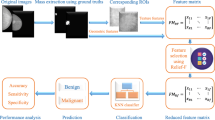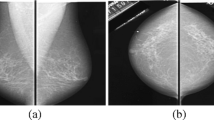Abstract
This paper proposes an improved computer-aided diagnosis model to identify mammographic images as normal or abnormal, and further, benign or malignant. The proposed scheme employs all the steps associated with other classification schemes; however, the contribution of the suggested scheme is fourfold. Initially, a fusion-based feature extraction method is employed to obtain the features using a combination of 2-D block discrete wavelet transform (2D-BDWT) and gray-level co-occurrence matrix (GLCM). Next, principal component analysis (PCA) is utilized to reduce the large dimension of the feature vector. Furthermore, to select the most optimal features from the reduced set of features, forest optimization algorithm (FOA) is used. The FOA-based feature selection algorithm is utilized as a wrapper-based technique which includes both feature selection and classification. In the proposed framework, several classifiers, namely support vector machine (SVM), k-nearest neighbor (k-NN), and decision tree (C4.5), are applied. The proposed method is compared with the benchmark schemes on two standard datasets, namely Mammographic Image Analysis Society (MIAS) and Digital Database for Screening Mammography (DDSM). Simulation results and analysis confirm that the proposed scheme brings potential improvements with respect to classification accuracy, sensitivity, specificity, area under curve, F-score, and Matthews correlation coefficient. The classification accuracy is measured with respect to normal versus abnormal and further, benign versus malignant. The proposed scheme with different combinations of classifiers, namely 2D-BDWT + GLCM + PCA + FOA + SVM, 2D-BDWT + GLCM + PCA + FOA + k-NN, and 2D-BDWT + GLCM + PCA + FOA + C4.5, achieves a maximum classification accuracy of 100% for both the MIAS and DDSM datasets.













Similar content being viewed by others
References
Abubacker NF, Azman A, Doraisamy S, Murad MAA (2017) an integrated method of associative classification and neuro-fuzzy approach for effective mammographic classification. Neural Comput Appl 28(12):3967–3980
Aminikhanghahi S, Shin S, Wang W, Jeon SI, Son SH (2017) a new fuzzy Gaussian mixture model (FGMM) based algorithm for mammography tumor image classification. Multimed Tools Appl 76(7):10,191–10,205
Azar AT, El-Said SA (2013) Probabilistic neural network for breast cancer classification. Neural Comput Appl 23(6):1737–1751
Beura S, Majhi B, Dash R (2015) Mammogram classification using two dimensional discrete wavelet transform and gray-level co-occurrence matrix for detection of breast cancer. Neurocomputing 154:1–14
Cheng H, Shi X, Min R, Hu L, Cai X, Du H (2006) Approaches for automated detection and classification of masses in mammograms. Pattern Recognit 39(4):646–668
Christopher MB (2016) Pattern recognition and machine learning. Springer, New York
de Lima SM, da Silva-Filho AG, dos Santos WP (2016) Detection and classification of masses in mammographic images in a multi-kernel approach. Comput Methods Programs Biomed 134:11–29
Dhahbi S, Barhoumi W, Kurek J, Swiderski B, Kruk M, Zagrouba E (2018) false-positive reduction in computer-aided mass detection using mammographic texture analysis and classification. Comput Methods Programs Biomed 160:75–83
Dheeba J, Singh NA, Selvi ST (2014) Computer-aided detection of breast cancer on mammograms: a swarm intelligence optimized wavelet neural network approach. J Biomed Inform 49:45–52
El-Naqa I, Yang Y, Wernick MN, Galatsanos NP, Nishikawa RM (2002) A support vector machine approach for detection of microcalcifications. IEEE Trans Med Imaging 21(12):1552–1563
Eltoukhy MM, Faye I, Samir BB (2012) A statistical based feature extraction method for breast cancer diagnosis in digital mammogram using multiresolution representation. Comput Biol Med 42(1):123–128
Ganesan K, Acharya UR, Chua CK, Min LC, Abraham KT, Ng KH (2013) Computer-aided breast cancer detection using mammograms: a review. IEEE Rev Biomed Eng 6:77–98
Gedik N (2016) A new feature extraction method based on multi-resolution representations of mammograms. Appl Soft Comput 44:128–133
Ghaemi M, Feizi-Derakhshi MR (2014) Forest optimization algorithm. Expert Syst Appl 41(15):6676–6687
Ghaemi M, Feizi-Derakhshi MR (2016) Feature selection using forest optimization algorithm. Pattern Recognit 60:121–129
Gonzalez RC, Woods RE (2012) Histogram processing. In: Digital image processing, 3rd edn. PHEI, Beijing, pp 162–165
Guo Y, Dong M, Yang Z, Gao X, Wang K, Luo C, Ma Y, Zhang J (2016) A new method of detecting micro-calcification clusters in mammograms using contourlet transform and non-linking simplified PCNN. Comput Methods Programs Biomed 130:31–45
Haralick RM, Shanmugam K et al (1973) Textural features for image classification. IEEE Trans Syst Man Cybern 6:610–621
Heath M, Bowyer K, Kopans D, Moore R, Kegelmeyer WP (2000) The digital database for screening mammography. In: Proceedings of the 5th international workshop on digital mammography. Medical Physics Publishing, pp 212–218
International Agency for Research on Cancer (2012) The GLOBOCAN project: cancer incidence and mortality worldwide in 2012. http://globocan.iarc.fr/. Accessed 13 Jan 2010
Jona J, Nagaveni N (2012) A hybrid swarm optimization approach for feature set reduction in digital mammograms. WSEAS Trans Inf Sci Appl 9:340–349
Kolb TM, Lichy J, Newhouse JH (2002) Comparison of the performance of screening mammography, physical examination, and breast us and evaluation of factors that influence them: an analysis of 27,825 patient evaluations. Radiology 225(1):165–175
Lewis C (1999) Fda sets higher standards for mammography. FDA Consum 33(1):13–17
Liu N, Qi ES, Xu M, Gao B, Liu GQ (2019a) A novel intelligent classification model for breast cancer diagnosis. Inf Process Manag 56(3):609–623
Liu X, Zhu T, Zhai L, Liu J (2019b) Mass classification of benign and malignant with a new twin support vector machine joint \(l_{2,1}\)-norm. Int J Mach Learn Cybern 10(1):155–171
Matthews BW (1975) Comparison of the predicted and observed secondary structure of t4 phage lysozyme. Biochim Biophys Acta (BBA) Protein Struct 405(2):442–451
Mohamed H, Mabrouk MS, Sharawy A (2014) Computer aided detection system for micro calcifications in digital mammograms. Comput Methods Programs Biomed 116(3):226–235
Pawar MM, Talbar SN (2016) Genetic fuzzy system (GFS) based wavelet co-occurrence feature selection in mammogram classification for breast cancer diagnosis. Perspect Sci 8:247–250
Rampun A, Scotney B, Morrow P, Wang H, Winder J (2018) Breast density classification using local quinary patterns with various neighbourhood topologies. J Imaging 4(1):14
Rouhi R, Jafari M (2016) Classification of benign and malignant breast tumors based on hybrid level set segmentation. Expert Syst Appl 46:45–59
Rouhi R, Jafari M, Kasaei S, Keshavarzian P (2015) Benign and malignant breast tumors classification based on region growing and cnn segmentation. Expert Syst Appl 42(3):990–1002
Siegel RL, Miller KD, Jemal A (2015) Cancer statistics, 2015. CA Cancer J Clin 65(1):5–29
Suckling J, Parker J, Dance D, Astley S, Hutt I, Boggis C, Ricketts I, Stamatakis E, Cerneaz N, Kok S et al (1994) The mammographic image analysis society digital mammogram database. Exerpta Med Int Congr Ser 1069:375–378
Thawkar S, Ingolikar R (2018a) Classification of masses in digital mammograms using biogeography-based optimization technique. J King Saud Univ Comput Inf Sci
Thawkar S, Ingolikar R (2018b) Classification of masses in digital mammograms using firefly based optimization. Int J Image Graph Signal Process 10(2):25–33
Wang S, Rao RV, Chen P, Zhang Y, Liu A, Wei L (2017) Abnormal breast detection in mammogram images by feed-forward neural network trained by Jaya algorithm. Fundam Inform 151(1–4):191–211
Xie W, Li Y, Ma Y (2016) Breast mass classification in digital mammography based on extreme learning machine. Neurocomputing 173:930–941
Yang L, Xu Z (2019) Feature extraction by PCA and diagnosis of breast tumors using SVM with DE-based parameter tuning. Int J Mach Learn Cybern 10(3):591–601
Author information
Authors and Affiliations
Corresponding author
Ethics declarations
Conflict of interest
The authors declare that they have no conflict of interest.
Additional information
Publisher's Note
Springer Nature remains neutral with regard to jurisdictional claims in published maps and institutional affiliations.
Rights and permissions
About this article
Cite this article
Mohanty, F., Rup, S., Dash, B. et al. Digital mammogram classification using 2D-BDWT and GLCM features with FOA-based feature selection approach. Neural Comput & Applic 32, 7029–7043 (2020). https://doi.org/10.1007/s00521-019-04186-w
Received:
Accepted:
Published:
Issue Date:
DOI: https://doi.org/10.1007/s00521-019-04186-w




